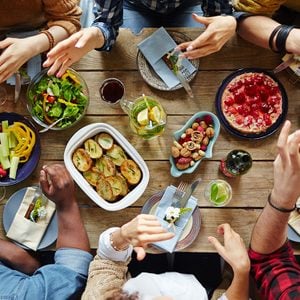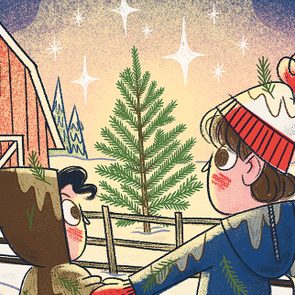Starting Christmas From Scratch

When Christmas celebrations with our extended families got to be too much, my wife and I took drastic measures.
In the late 1960s my father purchased a fake Christmas tree from Canadian Tire. It had long plastic needles, forest green with a hint of neon, and it smelled of chemicals. Its natural habitat was indoors amid polyester curtains and shag carpet. No one could ever mistake it for an actual tree.
My four older brothers and I adored that tree. Every year the five of us looked forward to the mid-December Sunday, after Mass, when our father would reach up to the highest shelf in the basement storage room and pull down the box of tree parts for us to assemble: first the aluminum stand, then the broomstick trunk, then the branches of varying lengths. My father padded the box with old newspapers, and we’d laugh at the headlines featuring politicians, athletes and celebrities of yore. It was a ritual all our own, and we delighted in it every year.
Other kids—and parents—were politely aghast at our tree. They said Christmas wasn’t Christmas without a real tree, and there was no point telling them how wrong they were. We knew it was absolutely possible to invest love and joy and gratitude in a fake tree, because that’s what we did. And our tree radiated as much true warmth as anyone’s.
Years later, as I grew up and caught glimpses of my friends’ traditions, I came to realize that we weren’t the only household with holiday quirks. Every family Christmas is an elaborate performance that looks weird from the outside—that’s precisely the source of its charm.
My brothers and I, even in adulthood and scattered across the continent, always made the late-December pilgrimage to our parents’ cottage in Canmore, Alberta, and to the familiar comforts and lifelong relationships that reconnected us to each other and to ourselves. I never even imagined celebrating Christmas anywhere else until I got married.
When you marry someone, the saying goes, you marry their family as well, and that includes their holiday rituals. When Lynn and I were wed in 2003, we did what most young couples do: we visited both our parents’ homes for the holidays.
Living in Peterborough, Ontario, we drove to Montreal to celebrate Christmas Eve with Lynn’s parents and brother and his family, where Christmas was never complete without herring salad, apparently a German tradition. Christmas morning was then spent travelling, as we flew to Calgary and drove to Canmore for the ever-growing Preville family gathering ’round the ol’ fake tree.

Then Lynn gave birth to our first son, and a few years later, to his twin baby brothers, and Christmas turned into a nightmare: long drives with three squirmy kids in the back, followed by long flights with our family of five squeezed into three economy seats strewn with board books and binkies.
My family’s brood had swollen to the point where we no longer fit in my parents’ home, so we’d set ourselves up in a rented condo and shuttle back and forth for baby feedings and early bedtimes. But we never acknowledged to each other how exhausting our holiday routine had become, because we wanted to give our children the same joys of Christmas that we knew as kids.
The other thing we didn’t acknowledge was that those holiday joys were waning fast. Travel weariness was only part of the problem; our relationships with our parents and siblings were increasingly stilted. We were all professionals with careers and parents with kids, yet in both households everyone treated each other like the teenagers we once were, not the adults we had become. Christmas was stuck in time, and so were we.
It all came to a head during the Quarantine Christmas of 2011. That’s the year we and our three sons came down with norovirus on the flight to Calgary. We holed up in our rented condo and spent the first 48 hours voiding our gastrointestinal tracts and the next 48 trying to ward off my mother, who see-sawed between loving concern (“I made you some chicken soup!”) and browbeating (“Enough is enough, come join the family!”).
We couldn’t get out of Canmore fast enough. By the time we did I was so strung out that, with my extended family present to wave goodbye, I backed the minivan into a signpost on the way out of the parking lot, leaving the bumper dangling. I drove to the airport in silence, knowing, with a mix of resignation and determination, that I was done going home for the holidays.
Every Family Christmas is an elaborate performance, and we are all so attached to our part in the play that we lose track of both the script and the audience. Who are we performing for, and why? We do it to reconnect with the family roles and relationships that shaped us in our formative years, but it’s a double-edged sword.
Since Lynn and I are the youngest in our families, that often meant being treated like, and behaving like, the “kid sibling” again. Those roles no longer bear any resemblance to us, but they are hard-wired. In moments like Christmas, so laden with tradition and expectation, it’s nearly impossible to rewrite the script.
Once we got back to Peterborough, Lynn and I vowed to blow Christmas up and rebuild it from scratch. We’d celebrate it in our own home and develop our own traditions, some borrowed, some new. It was not an easy transition. We bargained hard about which of our respective family rituals would remain part of our own hybrid Christmas.
The herring salad made the cut; I’ve come to enjoy it. And while we’ve adopted many of my favourite family traditions—including tourtière for breakfast on Christmas morning—we abandoned the fake tree. Lynn said Christmas just wouldn’t be Christmas without a real tree. There was no point telling her how wrong she was.
So now, every year, we bring a Nova Scotia pine into the house. I’ve put my own stamp on the ritual by sawing a puck-shaped disc from the bottom of each trunk; I’ve labelled and saved them all, and they adorn our hearth every December. In any event, the tree itself is less important than the love and joy and gratitude you invest in it—and who you do it for. My tree is no longer a monument to my brothers and parents but to my wife and kids, a change that was long overdue.
We finally made each other the focus of our Christmas, and we’ve never gone back.
Next, read the heartwarming story of how silly stocking stuffers became one family’s favourite tradition.






